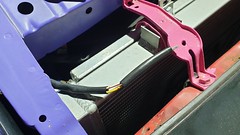Adapting radiator switch for AC cars with radiator sensor
Posted: 18/12/21 21:33
My situation - I have Rev2 Turbo, previous owner gutted AC, when my coolant reach over 90C my fans don't start and coolant starts boiling. This only happened once after returning to pits after track session. If I disconnect rad sensor plug fans spin at maximum speed.
My radiator sensor (https://toyota-europe.epc-data.com/mr2/ ... 01/88620C/ discontinued part) still might be fine, but I can't be bothered troubleshooting whole AC system - I have no AC anyway, so only need for fans to start once coolant is over 90C.
Solution - adapt radiator switch (https://toyota-europe.epc-data.com/mr2/ ... 401/89428/ from non AC cars readily available for £15 or even less) to work in AC car. Once coolant temperature reaches 90C rad switch breaks continuity, creating same situation as disconnecting plug, resulting in fans spinning at max speed.
Explanation of how I got to this approach
Original sensor uses resistance to report temperature:
Approx. 1.35k ohm at 85°C
Approx. 1.19k ohm at 90°C
Approx. 1.05k ohm at 95°C
Radiator switch has continuity until it reaches 90C, then it keeps circuit open until temperature drops to 85C
If you just plug radiator switch into AC car, fans will be spinning at maximum as car is thinking temperature is way over 95C as resistance is something like 0.001k ohm.
Trick is to make car thinking that coolant is not hot - as far as I can tell sensor is not used anywhere in engine management, only in controlling radiator fans and maybe something in AC which in my case doesn't matter.
So my solution was to add 2k ohm resistor onto one of the radiator sensor cables.
While coolant is below 90C sensor is showing 2k ohm - pretty much resistor value as radiator switch itself has negligible resistance. Car thinks coolant is cold and fans are not spinning
Coolant goes over 90C, radiator switch opens circuit breaking continuity and creating same situation as unplugging sensor. Fans are spinning at maximum
Coolant temperature drops below 85C, radiator switch closes circuit restoring continuity, car is reading 2k ohm again and fans stops




I've dry tested this with rad switch connected to the car, switch sitting in metal mug with water and mug being heated with a torch. As I still need to flush coolant and do other bits before taking car to MOT I will update this post later if I find something wrong with this setup.
My radiator sensor (https://toyota-europe.epc-data.com/mr2/ ... 01/88620C/ discontinued part) still might be fine, but I can't be bothered troubleshooting whole AC system - I have no AC anyway, so only need for fans to start once coolant is over 90C.
Solution - adapt radiator switch (https://toyota-europe.epc-data.com/mr2/ ... 401/89428/ from non AC cars readily available for £15 or even less) to work in AC car. Once coolant temperature reaches 90C rad switch breaks continuity, creating same situation as disconnecting plug, resulting in fans spinning at max speed.
Explanation of how I got to this approach
Original sensor uses resistance to report temperature:
Approx. 1.35k ohm at 85°C
Approx. 1.19k ohm at 90°C
Approx. 1.05k ohm at 95°C
Radiator switch has continuity until it reaches 90C, then it keeps circuit open until temperature drops to 85C
If you just plug radiator switch into AC car, fans will be spinning at maximum as car is thinking temperature is way over 95C as resistance is something like 0.001k ohm.
Trick is to make car thinking that coolant is not hot - as far as I can tell sensor is not used anywhere in engine management, only in controlling radiator fans and maybe something in AC which in my case doesn't matter.
So my solution was to add 2k ohm resistor onto one of the radiator sensor cables.
While coolant is below 90C sensor is showing 2k ohm - pretty much resistor value as radiator switch itself has negligible resistance. Car thinks coolant is cold and fans are not spinning
Coolant goes over 90C, radiator switch opens circuit breaking continuity and creating same situation as unplugging sensor. Fans are spinning at maximum
Coolant temperature drops below 85C, radiator switch closes circuit restoring continuity, car is reading 2k ohm again and fans stops




I've dry tested this with rad switch connected to the car, switch sitting in metal mug with water and mug being heated with a torch. As I still need to flush coolant and do other bits before taking car to MOT I will update this post later if I find something wrong with this setup.